Nissan VQ engine
| Nissan VQ engine | |
|---|---|
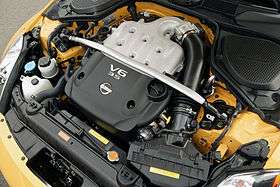 | |
| Overview | |
| Manufacturer | Nissan (Nissan Machinery) |
| Production | 1994–present |
| Layout | |
| Configuration | 60° V6 |
| Displacement |
2.0L 2.3L 2.5L 3.0L 3.5L 3.7L 4.0L |
| Cylinder block alloy | Aluminum |
| Cylinder head alloy | Aluminum |
| Valvetrain | DOHC |
| Chronology | |
| Predecessor |
Nissan VE engine Nissan VG engine V6 ESL engine |
| Successor | Nissan VR engine |
The VQ is a V6 piston engine produced by Nissan with displacements varying from 2.0 L to 4.0 L. It is an aluminum block DOHC 4-valve (per cylinder) design with aluminum heads. It is fitted with Nissan's EGI/ECCS sequential multi-point fuel injection (MPFI) system. Later versions feature various implementations of variable valve timing and replace MPFI with direct fuel injection (marketed as NEO-Di). The VQ series engine was honored by Ward's 10 Best Engines list almost every year from the list's inception. The VQ series replaced the VG series of engines.
DE series
VQ20DE
This DOHC 24-valve 2.0 L (1,995 cc) V6 has bore and stroke dimensions of 76 mm and 73.3 mm respectively, along with a compression ratio ranging from 9.5 to 10.0:1. It produces 150 PS (110 kW; 150 hp) to 160 PS (120 kW; 160 hp) @6400 rpm and 137 to 145 lb⋅ft (186 to 197 N⋅m) @4400 rpm (lean burn).
It is fitted to the following vehicles:
- 1994–2003 Nissan Cefiro A32 and A33
- 1995–1999 Nissan QX A32
VQ23DE
The VQ23DE is a 2.3 L (2,349 cc) engine equipped with CVTC (Continuously Variable-valve Timing Control). Bore and stroke are 85 mm and 69 mm, with a compression ratio of 9.8:1. It produces 173 PS (127 kW; 171 hp) @6000 rpm and 166 lb⋅ft (225 N⋅m) @4400 rpm.
It is fitted to the following vehicles:
- 2003–2008 Nissan Teana 230JM-J31
- Nissan Cefiro (Neo VQ23)
- 2006–present Renault Samsung SM7 177 PS (130 kW; 175 hp) (Neo VQ23)
- 2008–present Renault Safrane 177 PS (130 kW; 175 hp) (Neo VQ23)
VQ25DE
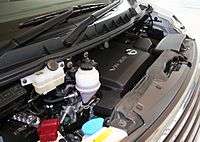
This engine is similar to the VQ20DE, but has a 2.5 L (2,495 cc) displacement. Bore and stroke are 85 mm and 73.3 mm, with a compression ratio of 9.8 to 10.3:1. It produces 189.99 PS (139.74 kW; 187.39 hp) to 209.99 PS (154.45 kW; 207.12 hp) @6400 rpm and 174 to 195 lb⋅ft (236 to 264 N⋅m) of torque. Later versions produce 186 PS (137 kW; 183 hp) @6000 rpm and 171 lb⋅ft (232 N⋅m) @3200 rpm. In some Nissan car, this engine replaced by QR25DE instead
It is fitted to the following vehicles:
- 1994–1998 Nissan Cefiro (A32)
- 2000–2003 Nissan Cefiro (A33)
- 1996–1999 Nissan Leopard (FY33)
- 1997–1999 Nissan Cedric (Y33)
- 2004–2007 Nissan Fuga (Y50)
- 2004–2007 Infiniti M (Y50)
- 2004–2010 Nissan Elgrand (E51)
- 2008–2011 Nissan Teana (J32)
- 2010–present Renault Samsung SM5 (L43) (178 PS)
- 2010–present Renault Latitude (L43) (178 PS)
VQ25DET
The VQ25DET is a turbocharged 2.5 L (2,495 cc) engine with CVTC. Bore and stroke are 85 mm and 73.3 mm, with a compression ratio of 8.5:1. It produces 279.99 PS (205.93 kW; 276.16 hp) @6400 rpm and 300 lb⋅ft (410 N⋅m) @3200 rpm.
It is fitted to the following vehicles:
- 2001–2004 Nissan Stagea 250t RS FOUR V, 250t RX FOUR and AR-X FOUR (NM-35)
- 2001– 2004 Autech Axis (NM35)
VQ30DE
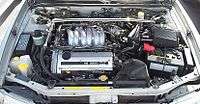
The 3.0 L (2,987 cc) VQ30DE has a bore and stroke of 93 mm and 73.3 mm respectively with a compression ratio of 10.0:1. It produces 193 PS (142 kW; 190 hp) to 226.99 PS (166.95 kW; 223.88 hp) @ 6400 rpm and 205 to 217 lb⋅ft (278 to 294 N⋅m) @4400 rpm. The VQ30DE was on the Ward's 10 Best Engines list from 1995 through 2001. It is an aluminum open deck block design with microfinished internals and a relatively light weight.
An improved version of the VQ30DE is known by the designation VQ30DE-K. The K designation stands for the Japanese word kaizen which translates to "improvement". The engine was used in the 2000–2001 Nissan Maxima and adds a true dual-runner intake manifold for better high-end performance compared to some earlier Japanese and Middle-East market versions of this engine (2000-2001 Infiniti I30 models added an additional fenderwell intake, boosting power to 227 ps). The VQ30DEK produces 226.99 PS (166.95 kW; 223.88 hp). The 1995–1999 US spec VQ30DE was equipped with only a single runner intake manifold.
It is fitted to the following vehicles:
- 1994–1998 Nissan Cefiro (A32), 220 PS (162 kW; 217 hp) and 206 lb⋅ft (279 N⋅m)
- 1995–1999 Nissan QX (A32)
- 1995–1999 Nissan Maxima (A32), 192 PS (141 kW; 189 hp) and 205 lb⋅ft (278 N⋅m)
- 1996–1999 Infiniti I30 (A32), 192 PS (141 kW; 189 hp) and 205 lb⋅ft (278 N⋅m)
- 2000–2001 Nissan Maxima (A33), 225 PS (165 kW; 222 hp) and 217 lb⋅ft (294 N⋅m); 227 PS (167 kW; 224 hp) for Anniversary Edition SE
- 2000–2001 Infiniti I30 (A33), 230 PS (169 kW; 227 hp) and 217 lb⋅ft (294 N⋅m)
- 1999–2003 Nissan Bassara U30, 223 PS (164 kW; 220 hp) and 206 lb⋅ft (279 N⋅m)
- 1998–2003 Nissan Presage U30, 223 PS (164 kW; 220 hp) and 206 lb⋅ft (279 N⋅m)
- 2002–2004 Dallara SN01, World Series by Nissan
VQ30DET
The 3.0 L (2,987 cc) VQ30DET is a turbocharged version of the VQ30DE. Bore and stroke remain the same at 93 mm and 73.3 mm respectively, and it has a compression ratio of 9.0:1. It produces 270 PS (200 kW; 270 hp) and 271 lb⋅ft (367 N⋅m). From 1998 onwards, it produces 280 PS (210 kW; 280 hp) @6000 rpm and 285 lb⋅ft (386 N⋅m) @3600 rpm.
It is fitted to the following vehicles:
- 1995–2004 Nissan Gloria Y33,Y34
- 1995–2004 Nissan Cedric Y33,Y34
- 1997–1999 Nissan Leopard Y33
- 1996–2001 Nissan Cima Y33
- 2001–2007 Nissan Cima F50
VQ30DETT
The twin-turbo VQ30DETT is an engine used only in Nissan's race cars, primarily in the Super GT (formerly the JGTC). First used on the Skyline GT-R race cars during the 2002 season, this engine subsequently powered the Fairlady Z race cars. Homologation rules allow them to use the VQ30DETT in lieu of the stock VQ35DE. Race output of this engine is estimated at around 480 PS (350 kW; 470 hp).
The VQ30DETT was replaced in 2007 by the VK45DE for use in the Super GT Fairlady Z's and later in the GT-R.
It was utilized in the following vehicles:
- 2002–2003 Skyline GT-R JGTC race cars (Non-Production)
- 2004 Fairlady Z JGTC race cars (Non-Production)
- 2005–2006 Fairlady Z Super GT race cars (Non-Production)
VQ35DE
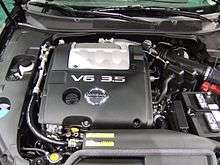
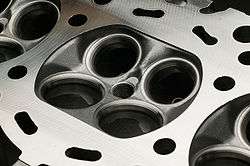
The 3.5 L (3,498 cc) VQ35DE is used in many modern Nissan vehicles. Bore and stroke are 95.5 mm and 81.4 mm. It uses a similar block design as the VQ30DE, but adds variable valve timing (CVTCS). It produces from 231 PS (170 kW; 228 hp) to 304 PS (224 kW; 300 hp) of power and 246 to 274 lb⋅ft (334 to 371 N⋅m) of torque depending on the application.
The VQ35DE is built in Iwaki and Decherd, TN. It was on the Ward's 10 Best Engines list from 2002 through to 2007 and again in 2016. It features forged steel connecting rods, a microfinished one-piece forged crankshaft, and Nissan's nylon intake manifold technology. It has low-friction molybdenum-coated pistons and the intake is a high-flow tuned induction system. Since its inception Nissan has improved upon the VQ35DE with changes keeping it an efficient class leading V6 engine.
A modified version of the VQ35DE, called the S1, is produced by Nismo (Nissan's motorsports and performance division) for the Fairlady Z S-Tune GT. It produces 300 PS (220 kW; 300 hp) at 7,200 rpm, a higher rev-limit than that of the original VQ35DE.
Independent tuners offer various packages utilizing Forced Induction and All Motor tuning. Power levels up to 420 hp NA and 1,000+ hp via turbocharging have been proven possible.
The VQ35DE is fitted to the following vehicles:
North American
- 2001–2004 Nissan Pathfinder- 240 hp (179 kW)
- 2013–2016 Nissan Pathfinder- 260 hp (194 kW) to 284 hp (212 kW)
- 2001–2003 Infiniti QX4- 240 hp (179 kW)
- 2001–2004 Infiniti I35- 255 hp (190 kW)
- 2002–present Nissan Altima- 240 hp (179 kW) to 270 hp (201 kW)
- 2002–present Nissan Maxima- 255 hp (190 kW) to 300 hp (224 kW)
- 2002–2006 Nissan 350Z- 287 hp (214 kW) to 300 hp (224 kW)
- 2002–2007 Infiniti G35 Coupe- 280 hp (209 kW) to 298 hp (222 kW)
- 2002–2006 Infiniti G35 Sedan- 260 hp (194 kW) to 298 hp (222 kW)
- 2002–2008 Infiniti FX35- 280 hp (209 kW)
- 2002–present Nissan Murano (Z50)- 240 hp (179 kW) to 265 hp (198 kW)
- 2003–2016 Nissan Quest- 235 hp (175 kW) to 260 hp (194 kW)
- 2004–2008 Infiniti M35- 275 hp (205 kW) to 280 hp (209 kW)
- 2012–2013 Infiniti JX35- 265 hp (198 kW)
- 2013–2016 Infiniti QX60- 265 hp (198 kW) to 295 hp (220 kW)
JDM and other markets
- 2000–present Nissan Elgrand 240 PS (180 kW; 240 hp)
- 2001–2007 Nissan Stagea 272 PS (200 kW; 268 hp) and above
- 2001–2009 Renault Vel Satis 241 PS (177 kW; 238 hp)
- 2002–2007 Nissan Skyline (V35) 272 PS (200 kW; 268 hp) and above
- 2003–present Nissan Teana/Cefiro (350JM-J31) 231 PS (170 kW; 228 hp)
- 2003–2009 Nissan Presage (231 hp)
- 2003–present Renault Espace 241 PS (177 kW; 238 hp)
- 2003–2004 Tatuus Formula V6, Formula Renault V6 Eurocup 370 hp (276 kW)
- 2004–2007 Nissan Fuga 350 GT 299.99 PS (220.64 kW; 295.89 hp)
- 2005–2006 Nismo Fairlady Z S-Tune GT 299.99 PS (220.64 kW; 295.89 hp) (VQ35DE S1 engine)
- 2005–2007 Dallara T05, World Series by Renault 425 PS (313 kW; 419 hp)
- 2006–present Renault Samsung SM7 217 PS (160 kW; 214 hp) (Neo VQ35)
- 2008–present Renault Laguna Coupé 241 PS (177 kW; 238 hp)
- 2008–2011 Dallara T08, World Series by Renault 425 PS (313 kW; 419 hp)
- 2010–present Renault Latitude 253 PS (186 kW; 250 hp)
- 2012–present Dallara T12, World Series by Renault 490 PS (360 kW; 480 hp)
VQ40DE
The VQ40DE is a 4.0 L (3,954 cc) longer stroke variant of the VQ35DE. Bore and stroke are 95.5 × 92.0 mm. Compression ratio is 9.5:1
Improvements include continuously variable valve timing, variable intake system, silent timing chain, hollow and lighter camshafts and friction reduction (microfinished surfaces, moly coated pistons). It is port fuel injected with platinum-tipped spark plugs. It produces 261 hp (195 kW) to 275 hp (205 kW) @5600 rpm and 281 lb⋅ft (381 N⋅m) to 288 lb⋅ft (390 N⋅m) @4000 rpm.
It is fitted to the following vehicles:
- 2005–present Nissan Frontier (268 hp @5600 rpm; 285 lb⋅ft (386 N⋅m) @4000 rpm)
- 2005–2015 Nissan Xterra (271 hp @5600 rpm; 294 lb⋅ft (399 N⋅m) @4000 rpm)
- 2005–2012 Nissan Pathfinder (269 hp @5600 rpm; 290 lb⋅ft (390 N⋅m) @4000 rpm)
- 2009–2013 Suzuki Equator (276 hp @5600 rpm; 283 lb⋅ft (384 N⋅m) @4000 rpm)
- 2012–present Nissan NV1500 (270 hp @5600 rpm; 291 lb⋅ft (395 N⋅m) @4000 rpm)
- 2012–present Nissan NV2500 HD (273 hp @5600 rpm; 288 lb⋅ft (390 N⋅m) @4000 rpm)
- 2012–present Nissan NV Passenger (261 hp @5600 rpm; 281 lb⋅ft (381 N⋅m) @4000 rpm)
- 2017–present Nissan Patrol (275 hp @5600 rpm; 290 lb⋅ft (390 N⋅m) @4000 rpm)
DD series
It is a variant of DE series engines with direct fuel injection (NEO-Di) and eVTC (electronically controlled continuously variable valve timing).
VQ25DD
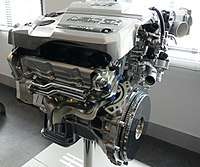
The 2.5 L (2,495 cc) engine has Bore and stroke of 85 mm and 73.3 mm respectively, with a compression ratio of 11 to 11.3:1. It produces 209.9 PS (154.4 kW; 207.0 hp) to 215 PS (158 kW; 212 hp) @6400 rpm and 195 to 199 lb⋅ft (264 to 270 N⋅m) @4400 rpm.
It is fitted to the following vehicles:
- 1999–2002 Nissan Cefiro A33, 209.9 PS (154.4 kW; 207.0 hp) (JDM)
- 1999–2004 Nissan Cedric/Nissan Gloria
- 2001–2006 Nissan Skyline V35, 215 PS (158 kW; 212 hp)
- 2001–2007 Nissan Stagea M35, 215 PS (158 kW; 212 hp)
VQ30DD
The 3.0 L (2,987 cc) engine has Bore and stroke of 93 mm and 73.3 mm, with a compression ratio of 11.0:1. It produces 231.54 PS (170.30 kW; 228.37 hp) to 258.78 PS (190.33 kW; 255.24 hp) @6400 rpm and 217 to 239 lb⋅ft (294 to 324 N⋅m) @3600 rpm.
It is fitted to the following vehicles:
- 1997–1999 Nissan Leopard Y33 231 PS (170 kW; 228 hp) and 217 lb⋅ft (294 N⋅m)
- 1999–2004 Nissan Cedric Y34
- 1999–2004 Nissan Gloria Y34 245 PS (180 kW; 242 hp) and 228 lb⋅ft (309 N⋅m)
- 2001–2004 Nissan Skyline V35
- 2001–2004 Nissan Stagea M35 258.78 PS (190.33 kW; 255.24 hp) and 239 lb⋅ft (324 N⋅m)
VQ35DD
A larger 3.5L with direct-injection is released for 2017 model year.
It is fitted to the following vehicles:
- 2017–present Nissan Pathfinder
- 2017–present Infiniti QX60
HR series
VQ25HR
The 2.5 L VQ25HR (for "High Revolution" or "High Response") is only offered on longitudinally-mounted engine vehicles which tend to be rear wheel drive or all-wheel drive. Bore and stroke are 85 mm and 73.3 mm, with a compression ratio of 10.3:1. It produces 221–228 PS (163–168 kW; 218–225 hp) @6,800 rpm and 194 lb⋅ft (263 N⋅m) @4,800 rpm. It has dual CVTC for both intake and exhaust, microfinished camshafts and a redline of 7,500 rpm.
It is fitted to the following vehicles:
- 2006–present Nissan Skyline V6 250GT Sedan - 229 PS (168 kW; 226 hp)
- 2006–present Nissan Fuga 250GT - 223 PS (164 kW; 220 hp)
- 2006–present Infiniti M V6 M25 Sedan - 218 hp (163 kW)
- 2010–present Infiniti EX J50 EX25 Crossover SUV - 222 PS (163 kW; 219 hp)
- 2011–2012 Infiniti G25 Sedan - 218 hp (163 kW)
- 2012–present Mitsubishi Proudia 250 VIP - 223 PS (164 kW; 220 hp)
VQ35HR
The VQ35HR engine was first seen in the US with the introduction of the updated 2007 G35 Sedan model, which debuted in August 2006. Nissan updated the VQ line with the addition of the 3.5 L VQ35HR (for "High Revolution"). It produces 315 PS (232 kW; 311 hp) (US market: 306HP using the revised SAE certified power benchmark) at 6,800 rpm and 37 kg⋅m (363 N⋅m; 268 lb⋅ft) at 4,800 rpm, using a compression ratio of 10.6:1. As of 2009, the Infiniti EX35 produces 297 hp and the same torque presumably due to tighter regulations. It has NDIS (Nissan Direct Ignition System) and CVTC with hydraulic actuation on the intake cam and electromagnetic on the exhaust cam. Redline is 7,600 rpm. Reportedly over 80% of the internal components were redesigned or strengthened to handle an increased RPM range sporting a lofty 7,600 rpm redline. A new dual-path intake (two air cleaners, throttle bodies, etc.) lowers intake tract restriction by 18 percent and new equal-length exhaust manifolds lead into mufflers that are 25 percent more free-flowing for all around better airflow. The electrically actuated variable valve timing on the exhaust cams to broaden the torque curve is new over the "DE" engine. The new engine block retained the same bore and stroke, but the connecting rods were lengthened and the block deck was raised by 8.4 mm to reduce piston side-loads. This modification, along with the use of larger crank bearings with main bearing caps reinforced by a rigid ladder-type main cap girdle to allow the engine reliably rev to 7600 rpm. With an increase in compression ratio from 10.3:1 to 10.6:1 these changes add 6 more horsepower (306 total + 3 hp ram air effect not measured by SAE testing = 309 hp). Peak torque is up 8 pound-feet from the older "DE" engine (260 vs. 268) and the torque curve is higher and flatter across most of the rpm range, and especially in the lower rpm range. The VQ35HR was utilized in rear-wheel-drive platforms while the VQ35DE continued to power Nissan's front-wheel-drive vehicles. In 2010 Nissan introduced a hybrid version of the VQ35HR, pairing the engine to a lithium-ion battery pack.
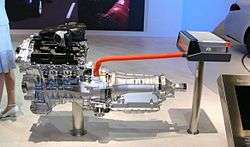
The VQ35HR fitted to the following vehicles:
- 2007–2008 Infiniti G35 Sedan- 306 hp (228 kW)
- 2007–2008 Nissan Skyline V36 350GT Sedan- 308 hp (230 kW)
- 2007–2008 Nissan 350Z- 313 hp (233 kW); US Market using revised SAE certified power benchmark - 306 hp (228 kW)
- 2006–2008 Nissan Fuga 350 GT- 308 hp (230 kW)
- 2008–2012 Infiniti EX35 Crossover SUV- 297 hp (221 kW)
- 2009–2012 Infiniti FX35 Crossover SUV- 303 hp (226 kW)
- 2009–2010 Infiniti M35- 303 hp (226 kW)
- 2011–2013 Infiniti M35h- Engine: 302 hp (225 kW), Combined: 360 hp (268 kW)
- 2010–present Nissan Fuga Hybrid- Combined: 360 hp (268 kW)
- 2012–present Nissan Cima- Combined: 360 hp (268 kW)
- 2012–present Mitsubishi Dignity- Combined: 360 hp (268 kW)
- 2014–present Infiniti Q50 Hybrid- Combined: 360 hp (268 kW)
- 2014–present Infiniti Q70 Hybrid- Combined: 360 hp (268 kW)
VQ38HR
By 2007, Nissans ambition to increase the competitiveness of the Z33 chassis in Super Taikyu racing resulted in the development of a larger displacement engine based on the original VQ35HR Block. The end result was the VQ38HR powered Nismo Type 380RS-C which went on to dominate ST class 1 racing. The 3.8-liter racing engine in the 380RS-C develops maximum power of more than 294Kw (400PS), and maximum torque of 421N•m (43.0 kg-m).[1] In order to use this new engine in Super GT GT500, limited numbers of the engine were reproduced in the street-legal Fairlady Z Nismo Type 380RS. The VQ38HR engine mounted in the 380RS is a detuned, street version of the racing engine used in the 380RS-C. The engine displacement remains the same, while the intake manifold and exhaust, air-fuel ratio, ignition timing, VTC and other specs have been optimized for street use. The engine produces maximum power of 257Kw (350PS) at 7200 rpm, and maximum torque of 397N•m (40.5 kg-m) at 4800rpm.[2]
The VQ38HR fitted to the following vehicles:
- 2007–2008 Nissan Fairlady Z Version Nismo Type 380RS-C
- 2007–2008 Nissan Fairlady Z Version Nismo Type 380RS
- 2007 Nissan Nismo z 380z built by Freshkiicks (UNVERIFIED)
Production
VQ35HR and VQ25HR engines were built at Nissan's Iwaki Plant in Fukushima Prefecture.[3][4]
VHR series
It is a variation of the VQ-HR engine series with Nissan's VVEL (Variable Valve Event and Lift).
VQ37VHR
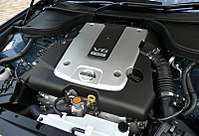
It was the first production engine from Nissan using VVEL. It has a compression ratio of 11.0:1, with a displacement of 3.7 L; 225.5 cu in (3,696 cc), thanks to a bore X stroke of 95.5 mm × 86 mm (3.76 in × 3.39 in) and a redline of 7,500 RPM. It is rated at 332 bhp (337 PS; 248 kW) @ 7,000 RPM and 270 lb⋅ft (366 N⋅m) of torque @ 5,200 RPM, and up to 350 bhp (355 PS; 261 kW) @ 7,400 RPM and 276 lb⋅ft (374 N⋅m) of torque @ 5,200 RPM. Although the engine VQ37VHR gains only 2 lb⋅ft (3 N⋅m) and 8 lb⋅ft (11 N⋅m) in the Nissan 370Z Nismo, torque over the VQ35HR and this higher torque arrives at 5,200 RPM vs 4800 RPM in the VQ35HR, the torque curve itself is improved and flattened via VVEL variable valve timing for better throttle response and low rpm torque.
It is fitted into the following vehicles:
- 2008–2013 Infiniti G37 Coupe- 330 hp (246 kW)
- 2008–present Nissan Skyline V36 370 GT Coupe- 330 hp (246 kW)
- 2009–2014 Infiniti G37 Sedan- 328 hp (245 kW)
- 2009–present Nissan Skyline V36 370 GT Sedan- 328 hp (245 kW)
- 2009–2013 Infiniti G37 Convertible- 325 hp (242 kW)
- 2009–present Nissan Fuga 370GT- 328 hp (245 kW)
- 2009–2013 Infiniti FX37- 325 hp (242 kW)
- 2009–2013 Infiniti EX37- 325 hp (242 kW)
- 2009–present Nissan 370Z/Fairlady Z- 332 hp (248 kW)
- 2009–present Nismo 370Z NISMO- 350 hp (261 kW)
- 2011–2013 Infiniti M37- 330 hp (246 kW)
- 2011–2016 Infiniti IPL G37 Coupe- 348 hp (260 kW)
- 2012–present Mitsubishi Proudia 370GT- 328 hp (245 kW)
- 2013 Infiniti IPL G37 Convertible- 343 hp (256 kW)
- 2014–2015 Infiniti Q50 Sedan- 328 hp (245 kW)
- 2014–2016 Infiniti Q60 Coupe- 330 hp (246 kW) to 348 hp (260 kW)
- 2014–2015 Infiniti Q60 Convertible- 325 hp (242 kW) to 343 hp (256 kW)
- 2014–present Infiniti Q70- 330 hp (246 kW)
- 2014–2017 Infiniti QX50- 325 hp (242 kW)
- 2014–2017 Infiniti QX70- 325 hp (242 kW)
See also
References
- ↑ http://www.nismo.co.jp/en/products/complete/380RS/2007/380rsc_spec.html
- ↑ http://www.nismo.co.jp/en/products/complete/380RS/engine.html
- ↑ NISSAN DEVELOPS NEW-GENERATION V6 ENGINES --Engines to power all-new Skyline to be released this autumn-- Archived 2010-01-18 at the Wayback Machine.
- ↑ 日産自動車、新世代V型6気筒エンジンを新開発、今秋発売の新型スカイラインに搭載 Archived 2011-03-22 at the Wayback Machine.
- "Powerful Pair: Nissan says new V6 engines increase power, fuel economy". AutoWeek. Retrieved 29 August 2006.
"Home of the VQ series Engine". VQpower. Retrieved 8 December 2012.